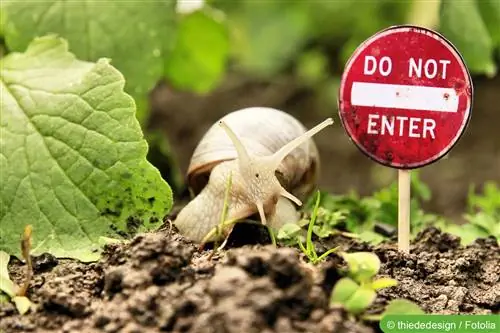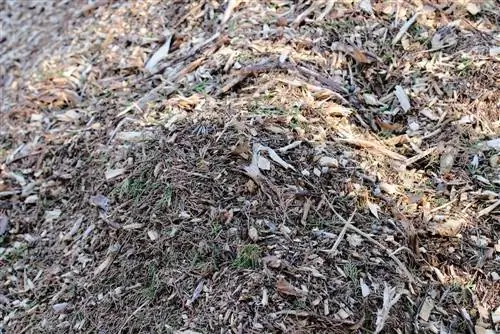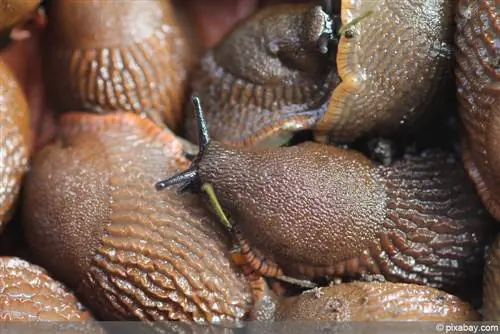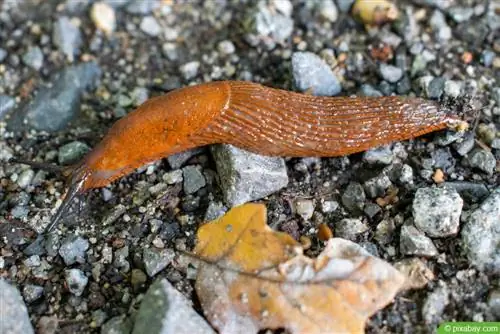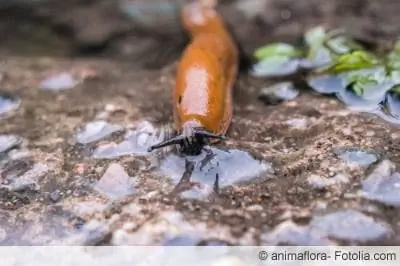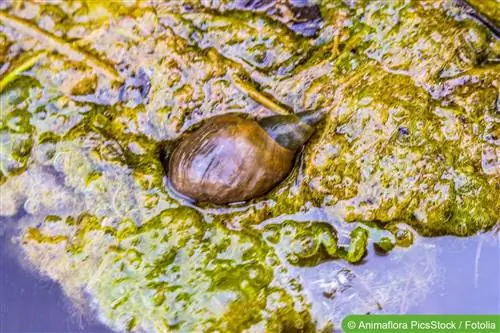- Author admin [email protected].
- Public 2023-12-17 03:39.
- Last modified 2025-06-01 06:48.
Snails can be extremely annoying in the garden. Eaten lettuce leaves are one of the most common signs of their presence and have spoiled the joy of home-grown vegetables for many a hobby gardener.
However, with a few gardening tricks as well as mechanical and chemical countermeasures, the plague can be contained.
Gardening tricks to repel snails
The fight against snails begins long before the actual gardening season. Even before the frost period in winter, the soil should be loosened up well with a rake so that severe frost can penetrate more easily and deeper. This kills snails overwintering in the ground and destroys their nesting sites. After the frost period, suitable planting of the beds and correct watering can help to curb the proliferation of snails in the garden. Vegetable beds and flowers should be kept in sunny and relatively dry locations as possible because snails avoid them. Damp and shady places form natural refuges for snails and are therefore not suitable for growing vegetables or flowers.
If boards are placed around the beds or as a stepping surface between beds, then they should be turned regularly. Snails feel particularly comfortable on the dark, moist underside of the boards, and the young animals in particular like to retreat there. When turning the boards, a few snails can usually be discovered and destroyed each time.
Watering can also promote or inhibit the spread of snails in the garden - depending on what time of day you water. It is advisable to water very heavily in the morning, while at most little watering should be done in the evening. If the beds are watered too heavily in the evening, they are particularly attractive to snails - with corresponding effects on the plants growing there.
Further measures to deter snails
Special seeds are now available for different types of vegetables and flowers, which are intended to produce particularly snail-resistant plants. Even if no one can give a 100% guarantee, this option is at least worth a try. If you want, you can initially use conventional and resistant seeds on neighboring areas in order to be able to assess later whether using the resistant seeds is actually worthwhile. When breeding these seeds, changes are sought that will cause the snails to dislike the plants in question. Mechanical and chemical defense measures have also proven effective. In practice, the following options are particularly important:
- Snail fences
- Moss Extracts
- Slug pellets
- Snail traps
- Beer trap and
- Snail poison.
The snail fence - an effective obstacle
A snail fence is both effective and animal-friendly; It is also suitable as a visual separation between beds and green areas. The concept of the snail fence is based on preventing the animals from getting onto the bed in the first place without having to catch or kill them. The protective effect comes from the fact that snails can overcome numerous flat, non-slip obstacles when crawling, but find less grip on very smooth and steep surfaces. That's why snail fences are usually made from smooth materials such as plastic or metal. It is crucial that the individual fence elements are high enough and connect to each other without any gaps.
Regular inspection of the snail fences is therefore essential. The minimum height for an effectively protective snail fence is ten centimeters. However, it should be noted that this information refers to the part of the fence that is visible above ground. However, the fence elements must be significantly higher so that they can be buried deep enough into the ground so that the fence is stable and still reaches the required minimum height. The fence elements are angled outwards at the top.
The snails that want to crawl up the fence end up in an upside down position, lose their footing and fall down outside the bed. It is important that no leaves or other plant parts rest on or lean against the fence, otherwise “bridges” would be created through which the snails could still get to the fenced-off bed.
Chemistry or nature? Snail poisons and snail traps
If beds or planters have borders made of wood, metal, plastic or stone, a snail repellent paste can also be applied to these, which will provide protection for several weeks and prevent snails from crawling over the affected areas. This is not a plant protection product, but rather a preparation with natural, oil-based active ingredients that is biodegradable. There are also special snail poisons in different forms of application. Snail pellets have proven particularly useful because they are a very gentle method of snail control for the rest of nature and especially for other animals.
Positive experiences have also been made with purchased or self-made moss extracts. Plants that have been treated with it are largely avoided by snails. Simple, inexpensive, successful but still not recommended in every situation is a beer trap, consisting of a plastic cup buried in the ground and half filled with beer. The smell of the beer attracts the snails, causing them to fall into the cup and drown. The method is risky in that it can also attract other snails from neighboring properties. The beer trap works particularly well in spring, when the food supply for the snails is still relatively low and the attraction of the beer is therefore particularly high.
Which method works best?
It is hardly possible to make a general statement about the best method for repelling snails, because the local conditions at the different locations have a major influence on success. In practice, it usually works to try out several methods in parallel or one after the other and then decide on the most effective one. It often makes sense to combine several methods to enhance the effect.
Summary: Snail defense in the garden season
Snails in the garden can become a real pest. People are very annoyed by the eaten flowers and the lettuce, which is littered with eaten spots, is also less appetizing. To prevent the snail plague, here are some tips for you that make life difficult for snails and slugs and are the basis for effective snail protection:
- InWinterTake precautions: The snails hibernate in the ground. If this is raked up and severe frost hits the ground, many of the snails will die because they cannot live at these temperatures.
- When buying seeds: There are now vegetable and flower seeds that are said to be resistant to snails. No one can give a 100% guarantee, but these plants don't like snails. So pay attention to the seeds.
- Till the soil: Raking up the soil destroys the nesting sites and prevents new snails. However, make sure that the soil is always fine-grained and not too coarse, otherwise snails can lay eggs here again.
- Location: Snails avoid a sunny and dry location. Vegetable beds and flowers should therefore be kept as sunny as possible.
- Watering in the morning: The beds should be watered in the morning if possible, then very heavily. If you water heavily in the evening, it particularly attracts snails, which will have fun with the plants the following night.
- Boards in beds: Snails, especially young snails, like to retreat under boards because it is dark and damp here. Turning the boards can make a big difference. The snails detected in this way can be destroyed directly.
- Snail fences: Snail fences are ideal for keeping snails out and also serve as visual separations in the garden.
Other options for combating and preventing snails include the snail fence, natural enemies of snails, moss extracts, snail pellets, the snail trap, the beer trap and snail poison.

